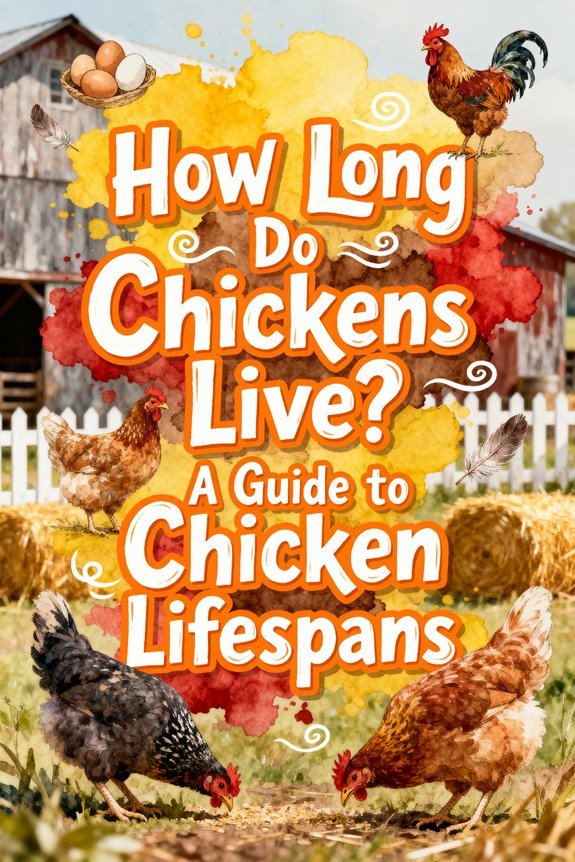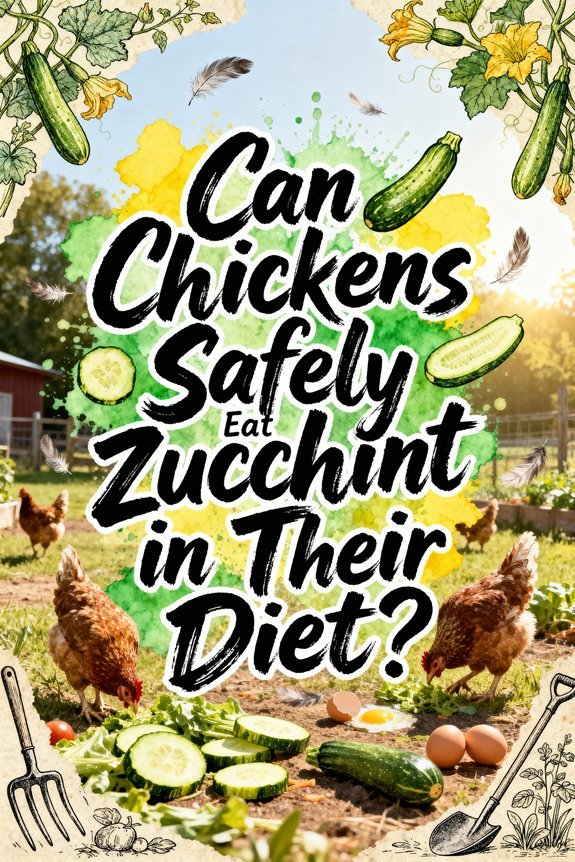Can Chickens Safely Eat and Digest Fresh Grass?
Yes, your chickens can safely eat fresh grass, but they’ll need proper management for ideal benefits. While grass provides 11-16% protein content and essential vitamins, chickens can’t efficiently digest cellulose, making it a supplement rather than a primary food source. You’ll need to cut grass into 1-inch lengths and limit portions to small daily handfuls per bird. Combining fresh grass with quality layer feed and grit guarantees your flock receives balanced nutrition through proven feeding strategies.
The Natural Benefits of Fresh Grass in a Chicken’s Diet
While chickens have traditionally been fed commercial feed, fresh grass provides a complex array of essential nutrients that can greatly enhance their diet and overall health. Fresh grass delivers substantial nutritional benefits, containing 11-16% protein content and abundant carotenoids that improve egg yolk quality. You’ll find it’s rich in critical vitamins like E, B6, C, and A, alongside significant minerals such as iron. This natural diet approach leads to reduced feeding costs through decreased reliance on commercial feed options. Similar to black oil sunflower seeds, grass should be offered as part of a balanced diet to avoid nutritional imbalances.
When you allow your chickens to forage on grass, you’re supporting their behavioral enrichment through natural foraging activities. This practice not only provides up to 25% of their daily nutrient requirements but also encourages the consumption of insects, which supplies additional amino acids. The combination of grass consumption and outdoor activity promotes vitamin D synthesis, strengthening bone health and immune function. Even breeds like Silkie chickens, which lay fewer eggs annually, benefit from grass foraging to maintain consistent egg production through winter months.
Understanding Digestive Health and Grass Consumption
Although chickens naturally gravitate toward grass consumption, their digestive system lacks the specialized mechanisms found in ruminants for processing cellulose effectively. You’ll find that chickens cannot produce the necessary digestive enzymes to break down grass fiber efficiently, resulting in minimal nutritional value from the grass itself. Providing insoluble grit stones is essential for proper grass digestion in chickens. Fresh grass clippings mulched finely can provide a safe and nutritious dietary supplement.
However, grass consumption does serve important digestive health functions. The dietary fiber supports gut motility and helps maintain healthy intestinal flora, while facilitating natural foraging behaviors. When your chickens peck at grass, they’re receiving supplementary micronutrients like vitamins A, E, and K, along with beneficial carotenoids. Yet, you must guarantee they have access to formulated feed, as grass alone cannot meet their protein and energy requirements. The true nutritional benefits of pasture come primarily from the insects and seeds chickens find while foraging. A balanced diet should include roughly one-third vegetation along with protein from insects and grains for optimal health.
Safe Grass Feeding Guidelines for Backyard Chickens
Implementing proper grass feeding guidelines guarantees ideal health and safety for your backyard chickens. Cut grass blades to 1-inch lengths to prevent crop impaction, and only offer fresh, same-day cuttings. Don’t use lawn mower clippings or chemically treated grass. Young grass seed heads provide both entertainment value and additional nutrients for chickens.
Consider grass alternatives like alfalfa, lucerne, and safe weeds such as dandelions, which provide superior nutritional value through vitamins A, B, C, E, K, iron, magnesium, and calcium. Adding fresh oregano to grazing areas can help protect chickens from parasites and boost their immune system naturally. You’ll want to limit portions to small handfuls per chicken daily, allowing them to maintain balanced nutrition from their primary feed.
Establish pesticide-free grazing areas and implement rotation to prevent overgrazing. Monitor your flock for adverse reactions after grass consumption, and maintain clean feeding areas to minimize parasite transmission risks.
Warning Signs of Grass-Related Health Issues
Identifying grass-related health issues in chickens requires vigilant monitoring of specific warning signs. Watch for neurological symptoms including staggering, weakness, and muscle tremors, which may indicate exposure to toxic compounds. You’ll need to observe for gastrointestinal distress like decreased appetite, diarrhea, and excessive salivation. Common poultry symptoms include labored breathing, pale combs, and cyanotic mucous membranes – particularly concerning with nitrate or prussic acid poisoning. Physical indicators such as skin irritation, embedded seed awns, or nasal discharge warrant immediate attention. Systemic toxicity can manifest through anemia, fever, and weight loss. If you notice convulsions, severe respiratory distress, or rapid deterioration, seek emergency veterinary care, as these conditions can quickly become fatal. Symptoms typically emerge within 15-20 minutes after consuming toxic grasses or forages containing prussic acid. Early detection and supportive care measures, including isolation and vitamin supplementation, can significantly improve recovery chances for affected birds. Consider installing protective netting over grazing areas to prevent hawks from targeting vulnerable chickens displaying these symptoms.
Enhancing Egg Quality Through Grass Foraging
While monitoring chickens for grass-related health concerns remains vital, the practice of grass foraging offers considerable benefits for egg quality and nutritional value. You’ll find that pasture benefits include notably enhanced vitamin E levels, particularly when hens consume grass rather than clover. Egg nutrition improves dramatically, with pasture-raised eggs containing 4.5 times more alpha-linolenic acid and double the EPA and DHA compared to eggs from caged hens. The diverse plant species in your pasture directly influence nutrient profiles, as hens consuming mixed forage access a broader range of phytochemicals and antioxidants. These nutrients transfer efficiently to egg yolks, especially fat-soluble vitamins and essential fatty acids. For peak results, you’ll want to implement rotational grazing, which guarantees sustainable nutrient supply and maintains consistent egg quality. Research shows that pastured hens produce eggs with 38% higher vitamin A compared to commercial eggs. Supplementing with complete layer feed ensures hens maintain optimal nutrition even when pasture quality varies throughout the year. Providing adequate amino acid balance through supplementation helps support feather development and overall health while grazing.
Balancing Fresh Grass With Other Feed Sources
Although fresh grass provides valuable nutrients for chickens, it cannot serve as a standalone feed source due to its limitations in energy density and essential amino acids. You’ll need to implement proper nutrient balancing by combining grass with concentrated feeds like corn, soybean meal, and vitamin-mineral premixes. Chickens lack the digestive enzymes needed to break down cellulose in grass effectively.
For ideal nutrition, structure your chickens’ diet with 60-70% grain and 20-25% protein meal, while grass incorporation should complement rather than replace these staples. You can safely include fermented grass at levels up to 5% of the total feed ration, which improves feed conversion and performance. When managing grass intake, monitor consumption to prevent excess fiber intake, which could interfere with nutrient absorption. Remember that commercial feed formulations remain essential for maintaining consistent nutritional levels that grass alone cannot provide. A quality layer feed with appropriate protein content should always be the foundation of your chickens’ diet. Providing oyster shells separately allows hens to regulate their calcium intake for strong eggshells.
Creating a Safe Grazing Environment
To establish a secure grazing environment for chickens, you’ll need to implement multiple protective measures across distinct zones of your farm. Set up a Controlled Access Zone around the barn’s exterior and a Restricted Area inside to minimize disease transmission from visitors and wildlife. Install electric fencing and overhead netting for predator protection while guaranteeing proper pop-hole placement every 15 meters. Keep the area free of dog waste hazards to prevent chickens from ingesting harmful bacteria and parasites.
Using a Hub System design, position the main coop centrally with radiating pasture zones to optimize grazing management and flock control.
For ideal grazing safety, maintain vegetated range areas and implement rotational grazing to prevent soil degradation and reduce parasite loads. Consider supplementing grazing with papaya treats to help control intestinal parasites naturally. You’ll need to monitor stocking densities carefully and move portable fencing regularly to provide fresh grazing sections. Install windbreaks to shield your flock from harsh weather, and guarantee they have access to shelters during inclement conditions. Manage manure accumulation effectively to minimize pathogen buildup in grazing zones.
Seasonal Considerations for Grass Feeding
Since seasonal changes dramatically affect forage availability, you’ll need to adjust your chickens’ grass feeding routine throughout the year. Seasonal forage fluctuations become most pronounced during fall when insect populations decline and grass growth slows. You’ll need to increase supplemental feed as natural nutrition sources diminish. Chickens will require more prepared feed intake during autumn months. Layer feed protein levels should stay between 16-18% when supplementing diminished forage.
Winter grazing challenges require specific management strategies. Your chickens will need more calories for heat generation, yet grass provides minimal nutritional value during cold months. Consider overseeding with winter-hardy forage crops or offering alternatives like kale and chard. Before dusk, provide scratch grains to help maintain body heat overnight. Offer dark leafy greens to maintain egg quality during scarce foraging periods.
In spring and summer, monitor fresh grass consumption carefully. While forage is abundant, limit access to fresh-cut grass clippings to prevent digestive issues like crop impaction and diarrhea.
Grass Management Strategies for Chicken Keepers
Effective grass management requires balancing your chickens’ foraging needs with lawn preservation strategies. To implement proper grass protection, maintain longer grass heights to strengthen root systems against scratching damage, and utilize mulched clippings as a protective layer. You’ll need to manage flock movement through rotational grazing systems, such as mobile chicken tractors, allowing grass recovery periods between uses.
Installing secure hardware cloth around grazing areas helps protect chickens from predators while they forage. Provide at least 4 square feet per bird in designated areas and install dust baths to prevent excessive lawn damage. A coarse sand bath helps keep chickens clean while protecting your lawn from destructive dust bathing behavior. You can mitigate nitrogen burn by diluting manure concentrations with regular hosing and ensuring even distribution. In heavily trafficked zones, consider supplementing with sand or pine shavings. For vulnerable areas or new growth, install temporary barriers while maintaining adequate space for natural foraging behaviors.



